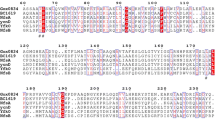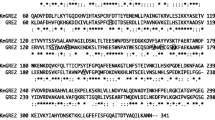Abstract
A novel protein from Gluconobacter oxydans DSM2003 which shows 60–70% similarity with members of aldo–keto reductase (AKR) superfamily was overexpressed in Escherichia coli BL21 (DE3) and purified by one step affinity chromatography with a Ni-NTA agarose column. The recombinant protein (named GOX0644) consists of 279 amino acids with an apparent molecular mass of 32 kDa in the soluble fraction, and the gene sequence encoding the protein GOX0644 is 100% identical to the ORF of gox0644 in G. oxydans 621H (DSM2343). For a detailed analysis of its enzymatic activity, the substrate specificity of the recombinant protein GOX0644 was determined. With NADPH as a cofactor, GOX0644 exhibited better activity to aromatic aldehydes, especially o-chlorobenzaldehyde, compared to aliphatic aldehydes. It showed almost no activity toward glyceraldehyde, xylose, glucose, and ketones. The protein was unable to oxidize primary- or secondary alcohols. Based on these results, GOX0644 was defined as a novel NADPH-dependent aldehyde reductase. Kinetic parameters of the protein and the dependence of its activity on temperature and pH were also determined.




Similar content being viewed by others
References
Deppenmeier, U., Hoffmeister, M., & Prust, C. (2002). Biochemistry and biotechnological applications of Gluconobacter strains. Applied Microbiology and Biotechnology, 60, 233–242.
Yang, X. P., Wei, L. J., Lin, J. P., Yin, B., & Wei, D. Z. (2008). A membrane-bound PQQ-dependent dehydrogenase in Gluconobacter oxydans M5 1s the primary source enzyme responsible for the oxidation of 1-(2-hydroxyethyl) amino-1-deoxy-d-sorbitol. Applied and Environmental Microbiology, 74, 5250–5253.
Xu, X., Chen, X., Jin, M., Wu, X., & Wang, X. (2009). Advance in dihydroxyacetone production by microbial fermentation. Sheng Wu Gong Cheng Xue Bao, 25, 903–908.
Hölscher, T., Schleyer, U., Merfort, M., Bringer-Meyer, S., Görisch, H., & Sahm, H. (2009). Glucose oxidation and PQQ-dependent dehydrogenases in Gluconobacter oxydans. Journal of Molecular Microbiology and Biotechnology, 16, 6–13.
Islami, M., Shabani, A., Saifi-Abolhassan, M., Sepehr, S. H., Soudi, M. R., & Mossavi-Nejad, S. Z. (2008). Purification and characterization of alcohol dehydrogenase from Gluconobacter suboxydans. Pakistan Journal of Biological Sciences, 11, 208–213.
Prust, C., Hoffmeister, M., Liesegang, H., Wiezer, A., Fricke, W. F., Ehrenreih, A., et al. (2005). Complete genome sequence of the acetic bacterium Gluconobacter oxydans. Nature Biotechnology, 23, 195–200.
Deppenmeier, U., & Ehrenreich, A. (2009). Physiology of acetic acid bacteria in light of the genome sequence of Gluconobacter oxydans. Journal of Molecular Microbiology and Biotechnology, 16, 69–80.
Richter, N., Neumann, M., Liese, A., Wohlgemuth, R., Eggert, T., & Hummel, W. (2009). Characterisation of a recombinant NADP-dependent glycerol dehydrogenase from Gluconobacter oxydans and its application in the production of l-glyceraldehyde. Chembiochem: A European Journal of Chemical Biology, 10, 1888–1896.
Wei, G. D., Yang, X. P., Gan, T. L., Zhou, W. Y., Lin, J. P., & Wei, D. Z. (2009). High cell density fermentation of Gluconobacter oxydans DSM2003 for glycolic acid production. Journal of Industrial Microbiology & Biotechnology, 36, 1029–1034.
Laemmli, U. K. (1970). Cleavage of structural proteins during the assembly of the head of bacteriophage T4. Natrue (London), 227, 680–685.
Bradford, M. M. (1976). A rapid and sensitive method for the quantitation of microgram quantities of protein utilizing the principle of protein-dye binding. Analytical Biochemistry, 72, 248–254.
Ye, Q., et al. (2009). A new member of the short-chain dehydrogenases/reductases superfamily: Purification, characterization and substrate specificity of a recombinant carbonyl reductase from Pichia stipitis. Bioresource Technology, 100(23), 6022–6027. doi:10.1016/j.biortech.2009.06.014.
Dixon, M., & Webb, E. C. (1979). Enzymes (3rd ed.). London: Longman.
Hayashi, T., Makino, K., Ohnishi, M., Kurokawa, K., & Ishii, K. (2001). Complete genome sequence of enterohemorrhagic Escherichia coli O157:H7 and genomic comparison with a laboratory strain K-12. DNA Research, 8, 11–22.
Sakai, A., Katayama, K., Katsuragi, T., & Tani, Y. (2001). Glycolaldehyde-forming route in Bacillus subtilis in relation to vitamin B6 biosynthesis. Journal of Bioscience and Bioengineering, 91, 147–152.
Willey, D. L., Caswell, D. A., Lowe, C. R., & Bruce, N. C. (1993). Nucleotide sequence and over-expression of morphine dehydrogenase, a plasmid-encoded gene from Pseudomonas putida M10. Biochemical Journal, 290(PT 2), 539–544.
Schweiger, P., & Deppenmeier, U. (2009). Analysis of aldehyde reductases from Gluconobacter oxydans 621H. Applied Microbiology and Biotechnology, 85(4), 1025–1031. doi:10.1007/s00253-009-2154-x.
Kita, K., Matsuzaki, K., Hashimoto, T., Yanase, H., Kato, N., Chung, M. C. M., et al. (1996). Cloning of the aldehyde reductase gene from a red yeast, Sporobolomyces salmonicolor, and characterization of the gene and its product. Applied and Environmental Microbiology, 62, 2303–2310.
Petrash, J. M. (2004). All in the family: Aldose reductase and closely related aldo-keto reductases. Cellular and Molecular Life Sciences (CMLS), 61, 737–749.
Li, T., & Rosazza, J. P. (2000). The carboxylic acid reduction pathway in Nocardia: Purification and characterization of the aldehyde reductase. Journal of Industrial Microbiology & Biotechnology, 25, 328–332.
Colrat, S., Latche, A., Huis, M., Pech, J. C., Bouzayen, M., Fallot, J., et al. (1999). Purification and characterization of a NADPH-dependent aldehyde reductase from mung bean that detoxifies eutypine, a Toxin from Eutypa lata1. Plant Physiology, 119, 621–626.
Habrych, M., Rodriguez, S., & Stewart, J. D. (2002). Purification and identification of an Escherichia coli β-keto ester reductase as 2,5-diketo-d-gluconate reductase YqhE. Biotechnology Progress, 18, 257–261.
Acknowledgment
This study was financially supported by The National Key Basic Research Development Program of China (NO. 2009CB724703) and National Natural Science Foundation of China (Grant No. 20976053/B060804).
Author information
Authors and Affiliations
Corresponding author
Rights and permissions
About this article
Cite this article
Chen, M., Lin, J., Ma, Y. et al. Characterization of a Novel NADPH-Dependent Oxidoreductase from Gluconobacter oxydans . Mol Biotechnol 46, 176–181 (2010). https://doi.org/10.1007/s12033-010-9283-4
Published:
Issue Date:
DOI: https://doi.org/10.1007/s12033-010-9283-4




